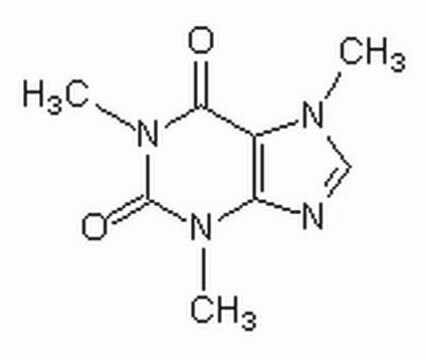W222402
Caffeina
anhydrous, 99%, FCC, FG
Sinonimo/i:
1,3,7-trimetilxantina
About This Item
Prodotti consigliati
Origine biologica
synthetic
Livello qualitativo
Grado
FG
Halal
Kosher
anhydrous
Conformità normativa
EU Regulation 1334/2008 & 178/2002
FCC
FDA 21 CFR 182.1180
Saggio
99%
Forma fisica
powder
Punto di fusione
234-236.5 °C (lit.)
Solubilità
H2O: soluble 18.7 g/L at 16 °C
applicazioni
flavors and fragrances
Documentazione
see Safety & Documentation for available documents
Allergene alimentare
no known allergens
Organolettico
odorless
Stringa SMILE
CN1C(=O)N(C)c2ncn(C)c2C1=O
InChI
1S/C8H10N4O2/c1-10-4-9-6-5(10)7(13)12(3)8(14)11(6)2/h4H,1-3H3
RYYVLZVUVIJVGH-UHFFFAOYSA-N
Informazioni sul gene
human ... ADORA1(134) , ADORA2B(136) , ADORA3(140) , PDE4B(5142)
mouse ... Adora2b(11541)
rat ... Adora1(29290) , Adora2a(25369)
Cerchi prodotti simili? Visita Guida al confronto tra prodotti
Categorie correlate
Descrizione generale
Applicazioni
- Anti-hair loss effect of a shampoo containing caffeine and adenosine.: Discusses the efficacy of a shampoo formulated with caffeine and adenosine in reducing hair loss, underscoring caffeine′s role in enhancing hair follicle activity and promoting hair health (Chen et al., 2024).
Prodotti correlati
Avvertenze
Warning
Indicazioni di pericolo
Consigli di prudenza
Classi di pericolo
Acute Tox. 4 Oral
Codice della classe di stoccaggio
11 - Combustible Solids
Classe di pericolosità dell'acqua (WGK)
WGK 1
Dispositivi di protezione individuale
dust mask type N95 (US), Eyeshields, Faceshields, Gloves
Scegli una delle versioni più recenti:
Possiedi già questo prodotto?
I documenti relativi ai prodotti acquistati recentemente sono disponibili nell’Archivio dei documenti.
I clienti hanno visto anche
Il team dei nostri ricercatori vanta grande esperienza in tutte le aree della ricerca quali Life Science, scienza dei materiali, sintesi chimica, cromatografia, discipline analitiche, ecc..
Contatta l'Assistenza Tecnica.





